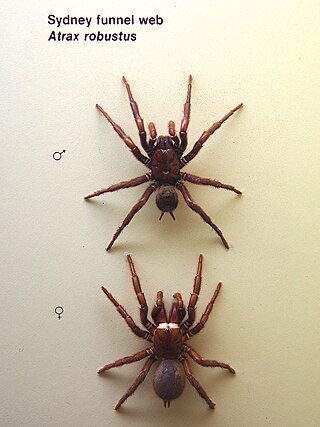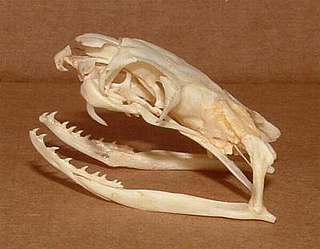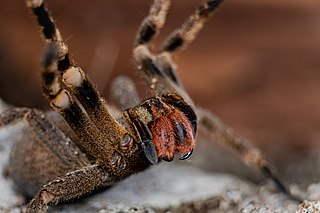
Phoneutria is a genus of spiders in the family Ctenidae. They are mainly found in northern South America, with one species in Central America. Members of the genus are commonly referred to as Brazilian wandering spiders. Other English names include armed spiders and banana spiders.

Antivenom, also known as antivenin, venom antiserum, and antivenom immunoglobulin, is a specific treatment for envenomation. It is composed of antibodies and used to treat certain venomous bites and stings. Antivenoms are recommended only if there is significant toxicity or a high risk of toxicity. The specific antivenom needed depends on the species involved. It is given by injection.
In toxicology, the lethal dose (LD) is an indication of the lethal toxicity of a given substance or type of radiation. Because resistance varies from one individual to another, the "lethal dose" represents a dose at which a given percentage of subjects will die. The lethal concentration is a lethal dose measurement used for gases or particulates. The LD may be based on the standard person concept, a theoretical individual that has perfectly "normal" characteristics, and thus not apply to all sub-populations.

Wandering spiders (Ctenidae) are a family of spiders that includes the Brazilian wandering spiders. These spiders have a distinctive longitudinal groove on the top-rear of their oval carapace similar to those of the Amaurobiidae. They are highly defensive and venomous nocturnal hunters. Wandering spiders are known to hunt large prey, for example hylid species Dendropsophus branneri. Despite their notoriety for being dangerous, only a few members of Phoneutria have venom known to be hazardous to humans, but the venoms of this family are poorly known, so all larger ctenids should be treated with caution.

The Sydney funnel-web spider is a species of venomous mygalomorph spider native to eastern Australia, usually found within a 100 km (62 mi) radius of Sydney. It is a member of a group of spiders known as Australian funnel-web spiders. Its bite is capable of causing serious illness or death in humans if left untreated.

The monocled cobra, also called monocellate cobra and Indian spitting cobra, is a venomous cobra species widespread across South and Southeast Asia and listed as Least Concern on the IUCN Red List.

Venomous snakes are species of the suborder Serpentes that are capable of producing venom, which they use for killing prey, for defense, and to assist with digestion of their prey. The poison is typically delivered by injection using hollow or grooved fangs, although some poisonous snakes lack well-developed fangs. Common venomous snakes include the families Elapidae, Viperidae, Atractaspididae, and some of the Colubridae. The toxicity of venom is mainly indicated by murine LD50, while multiple factors are considered to judge the potential danger to humans. Other important factors for risk assessment include the likelihood that a snake will bite, the quantity of poison delivered with the bite, the efficiency of the delivery mechanism, and the location of a bite on the body of the victim. Snake poison may have both neurotoxic and hemotoxic or cytotoxic properties. There are about 600 venomous snake species in the world.

Echis is a genus of vipers found in the dry regions of Africa, the Middle East, India, Sri Lanka and Pakistan. They have a characteristic threat display, rubbing sections of their body together to produce a "sizzling" warning sound. The name Echis is the Latin transliteration of the Greek word for "viper" (ἔχις). Like all vipers, they are venomous. Their common name is "saw-scaled vipers" and they include some of the species responsible for causing the most snakebite cases and deaths in the world. Twelve species are currently recognized.

Naja is a genus of venomous elapid snakes commonly known as cobras. Members of the genus Naja are the most widespread and the most widely recognized as "true" cobras. Various species occur in regions throughout Africa, Southwest Asia, South Asia, and Southeast Asia. Several other elapid species are also called "cobras", such as the king cobra and the rinkhals, but neither is a true cobra, in that they do not belong to the genus Naja, but instead each belong to monotypic genera Hemachatus and Ophiophagus.

Phoneutria nigriventer is a species of medically significant spider in the family Ctenidae, found in the Southern Cone of South America. Along with other members of the genus, they are often referred to as Brazilian wandering spiders.
Phoneutria reidyi is a species of venomous spiders in the family Ctenidae, found in South America.

Montivipera xanthina, known as the rock viper, coastal viper, Ottoman viper, and by other common names, is a viper species found in northeastern Greece and Turkey, as well as certain islands in the Aegean Sea. Like all other vipers, it is venomous. No subspecies are currently recognized.

Diplura is a genus of South American curtain web spiders that was first described by C. L. Koch in 1850. It is found in South America and Cuba belonging to the subfamily Diplurinae. They possess a lyra on their prolateral maxillae. Diplura species can be distinguished from Trechona sp. by the number of setae on this lyra. They differ from Harmonicon sp. by the leg formula and the shape of the lyra bristles.

Crotalus durissus, known as the South American rattlesnake, tropical rattlesnake, and by other names, is a highly venomous pit viper species found in South America. It is the most widely distributed member of its genus. Currently, seven subspecies are recognized.
Aipysurus duboisii, also known commonly as Dubois' sea snake and the reef shallows sea snake, is a species of extremely venomous snake in the subfamily Hydrophiinae of the family Elapidae. Its geographic range includes Papua New Guinea, New Caledonia and the northern, eastern and western coastal areas of Australia, that is the Coral Sea, Arafura Sea, Timor Sea and Indian Ocean. It lives at depths up to 80 meters in coral reef flats, sandy and silty sediments which contain seaweed, invertebrates and corals or sponges that can serve as shelter. It preys upon moray eels and various fish that live on the seafloor, up to 110 cm in size. A. duboisii is viviparous, giving birth to live young rather than laying eggs. It displays medium aggressiveness, i.e., will bite if provoked, but not spontaneously. The fangs are 1.8 mm long, which are relatively short for a snake, and the venom yield is 0.43 mg. Aipysurus duboisii is a crepuscular species, meaning that it is most active at dawn and dusk.

Latrodectus curacaviensis is a species of black widow spider, that belongs to the genus Latrodectus. It is known as the South American black widow, Brazilian black widow or Araña del trigo.
Loxosceles similis, is a species of a venomous recluse spider endemic to South America.
Trechona venosa is a species of a venomous spider edemic to South America.












